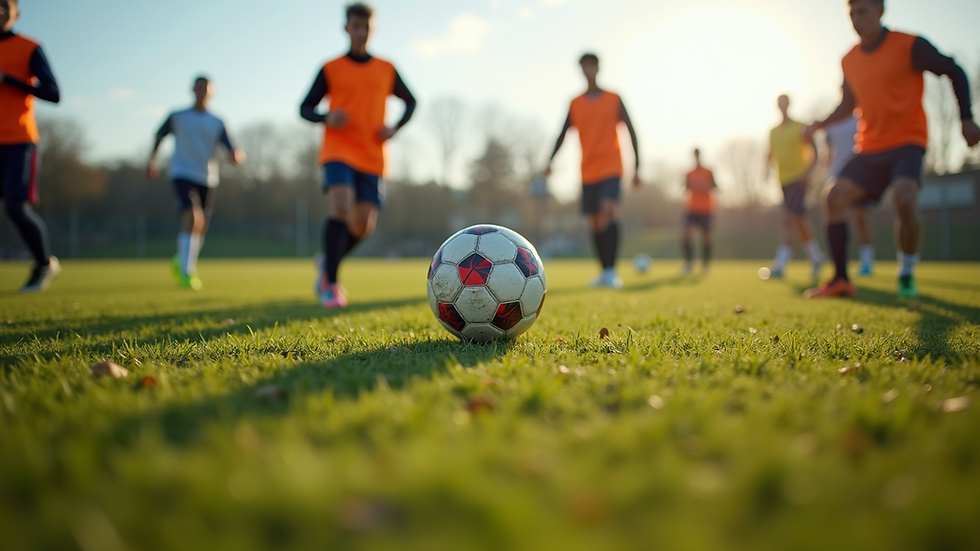Adapting Training For Different Age Groups in Football
- Mohammad Reza Shoaripour
- Jun 24
- 4 min read
In football, effective training isn’t one-size-fits-all. Each age group has unique developmental needs that coaches must address. When training is tailored to suit the specific skills, physical attributes, and mental capacities of youth, teens, and adults, it not only boosts individual player performance but also enhances team success. This guide will delve into best practices for adapting training for different age groups.
Understanding Developmental Stages
Recognizing the developmental stages of your players is key to effective training. Children, teenagers, and adults develop in distinct physical, cognitive, and emotional ways.
Under 8 (Ages 5–7)
At this early stage, our focus is on creating a joyful and engaging environment. Players are introduced to football through fun movement games, basic ball control, and social interaction. The goal is to build confidence, coordination, and a love for playing.
Under 10 (Ages 8–9)
Here we begin shaping the foundation of technical skills — dribbling, passing, shooting — while encouraging teamwork and creativity. Sessions are designed to stimulate decision-making and teach players how to express themselves on the ball, all in a supportive setting.
Under 13 (Ages 10–12)
Players at this age start developing tactical awareness and game understanding. We introduce more structured team play, positional awareness, and simple game strategies. Fitness training begins to support stamina, agility, and injury prevention.
Under 15 (Ages 13–14)
This phase is where we see rapid physical growth and increased game intensity. Training includes advanced technical development, match analysis, and role-specific tactics. We also focus on mental strength and adaptability to prepare players for higher levels.
Under 18 (Ages 15–17)
Our U18 program is designed for serious players aiming for professional pathways. Sessions replicate high-level match conditions, with a focus on competitive readiness, strength & conditioning, performance analysis, and exposure to local and international opportunities.
Training for Youth Players
Training for youth players should prioritize skill development and enjoyment. Here are some effective strategies:
Focus on Fundamental Skills
Basic skills such as dribbling, passing, shooting, and defending are the cornerstones of youth football. Engaging in small-sided games provides young players more touches on the ball, leading to better skill acquisition. For example, a 3v3 game allows each player to have approximately 33% more ball contact compared to an 11v11 match.
Encourage Fun and Engagement
Keeping sessions enjoyable is essential for maintaining interest. Use games and playful drills that feel more like play rather than structured training. For instance, introducing a "skills challenge," where players earn points for completing dribbling or passing tasks, keeps the mood light and encourages participation.
Tips
Incorporate varied physical activities that extend beyond football. Activities such as running, jumping, and balance exercises develop athletic skills and promote injury prevention. In fact, research shows that early exposure to diverse physical activities can reduce the risk of injuries by up to 50% in young athletes.
Training for Teen Players
As players transition into their teenage years, training should evolve to include more complex elements:
Introduce Tactics and Strategy
Teen players should start learning about football tactics. Conduct discussions on formations, team roles, and game analysis. For example, teaching a 4-3-3 formation will help players understand their responsibilities and how to make quick decisions during matches.
Emphasize Physical Conditioning
At this point of rapid physical development, incorporating strength and conditioning training becomes essential. Programs that focus on agility, speed, and endurance can lead to noticeable improvements; studies indicate these targeted workouts can enhance speed by 10-15% in young athletes when consistently applied.
Creating a Competitive Environment
Including competitive scenarios in practices can motivate players and foster teamwork. Organize small-sided tournaments where players can apply their tactical knowledge under pressure. This not only builds their confidence but also improves their strategic thinking on the pitch.
Training for Adult Players
For adult players, the focus shifts primarily to performance and tactical readiness.
Performance Enhancement
Training should include detailed tactics and fitness sessions aimed at maximizing performance. Video analysis tools can help players identify strengths and weaknesses. For instance, recent studies show that players who receive video feedback can improve their performance metrics by up to 25%.
Recovery and Injury Prevention
As players age, recovery becomes vital. Incorporate flexibility training and strength sessions, along with recovery techniques like physiotherapy and nutrition advice. Research suggests that athletes who follow a structured recovery protocol can reduce injury rates by 30% or more.
Psychological Preparation
Mental training is crucial for adult players. Incorporate exercises that help athletes manage stress and build confidence, such as visualization techniques and pressure scenarios. Understanding how to mentally prepare can lead to improved performance in high-stakes situations, an essential aspect of competitive football.
Developing Future Football Excellence
Adapting football training for different age groups is imperative for nurturing talent. Coaches must recognize the unique characteristics of youth, teen, and adult players to create effective training programs. By focusing on skill development for youth, introducing tactics and conditioning for teens, and emphasizing performance and recovery for adults, coaches lay the groundwork for successful player development. As players grow from youth to adults, these tailored approaches will help cultivate skilled, confident footballers ready to excel in their sport.




